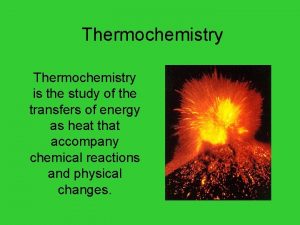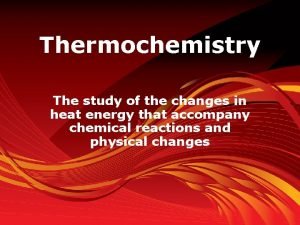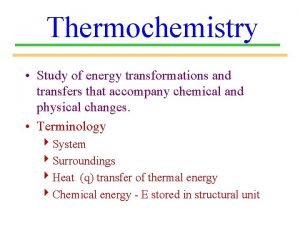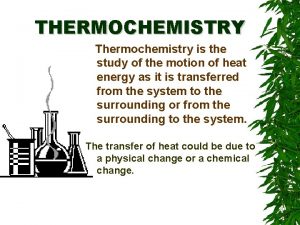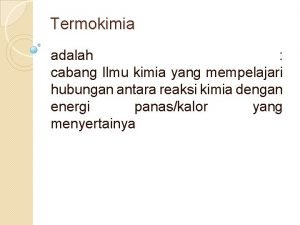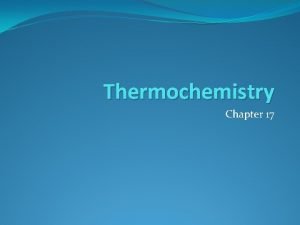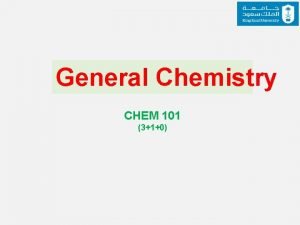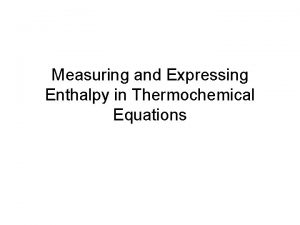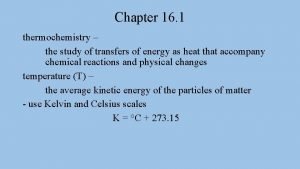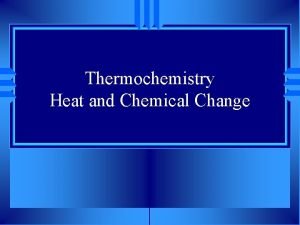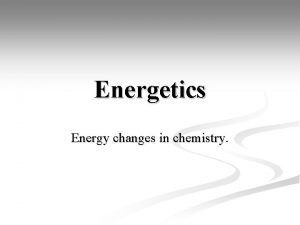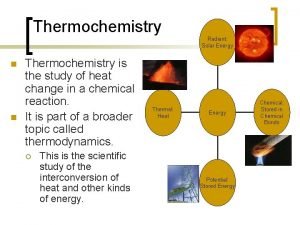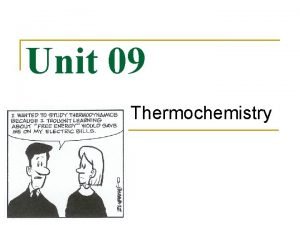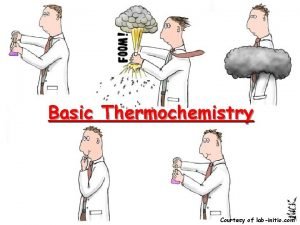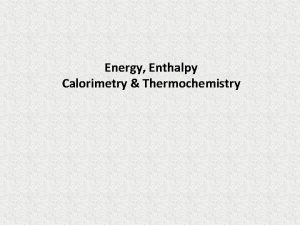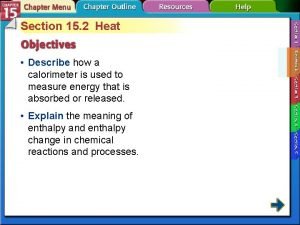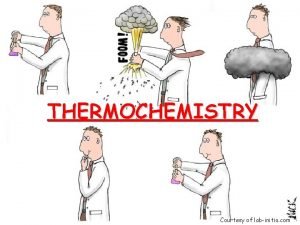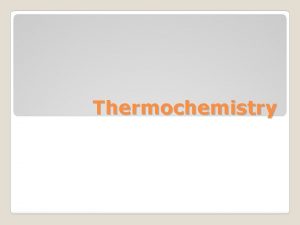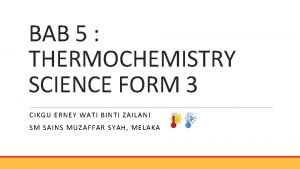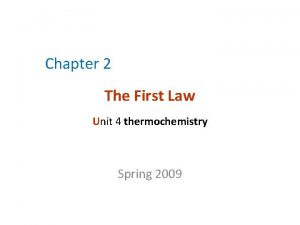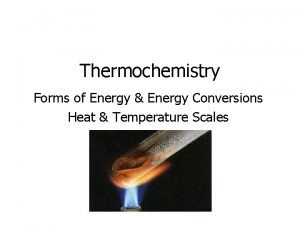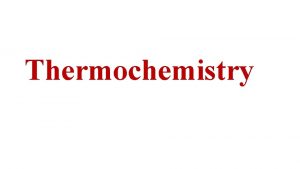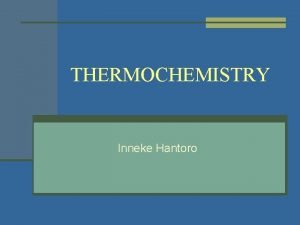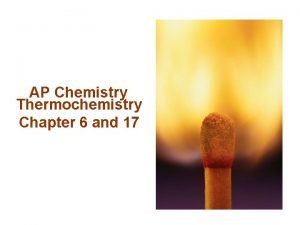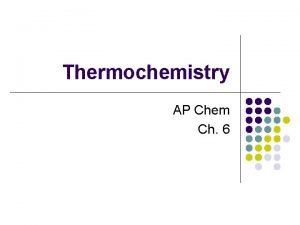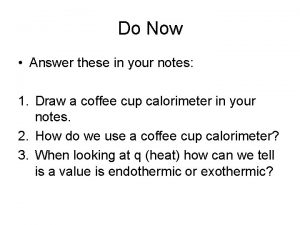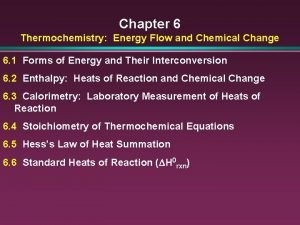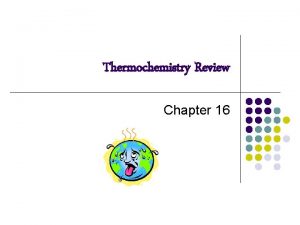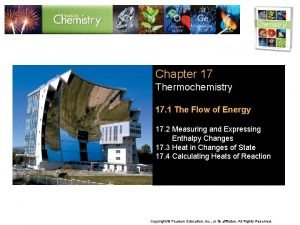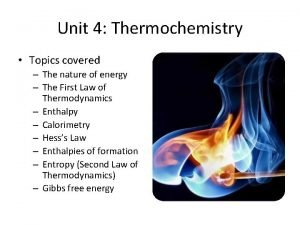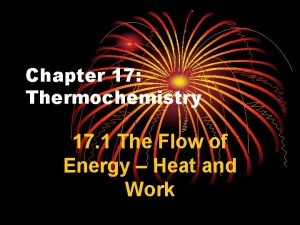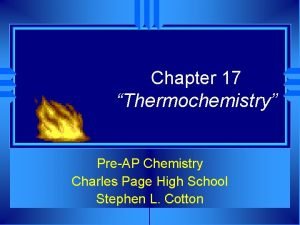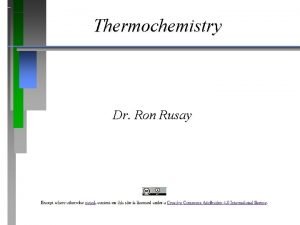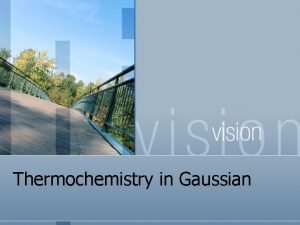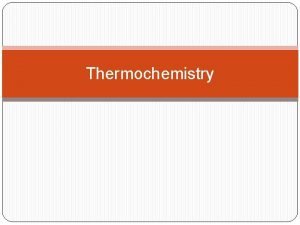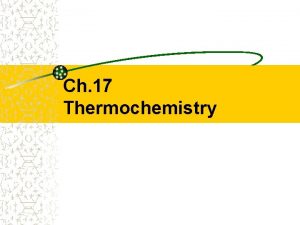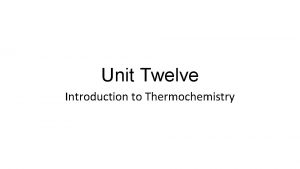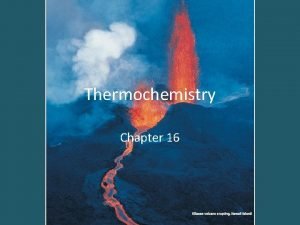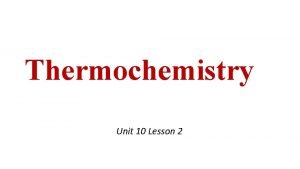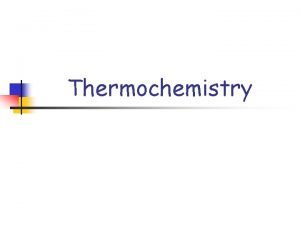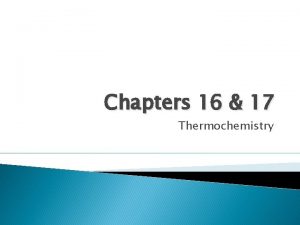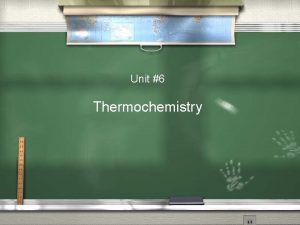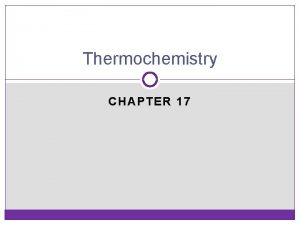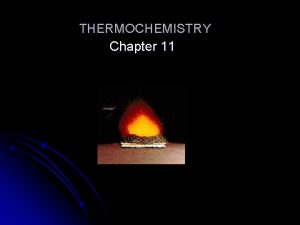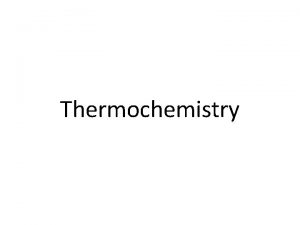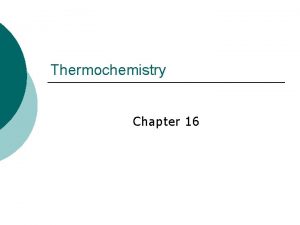Thermochemistry is the study of the transfers of





































- Slides: 37

Thermochemistry is the study of the transfers of energy as heat that accompany chemical reactions and physical changes.

Objectives 1. Define temperature and state the units in which it is measured. 2. Define heat and state its units. 3. Perform specific-heat calculations. 4. Explain enthalpy change, enthalpy of reaction, enthalpy of formation, and enthalpy of combustion. 5. Solve problems involving enthalpies of reaction, enthalpies of formation, and enthalpies of combustion.

Energy • Energy - the capacity for doing work or supplying heat • Chemical potential energy – the energy stored within the structural units of chemical substances • Different substances store different amounts of energy. The kinds of atoms and their arrangement in the substance determine the amount of energy stored in the substance. • All energy in a process can be accounted for as work, stored energy, or heat • Law of Conservation of Energy – In any physical or chemical process, energy is neither created not destroyed

Heat (q) – the energy lost or gained • Heat – energy that transfers from one object to another because of a temperature difference between them • Cannot be detected by the senses or instruments • Only changes caused by heat can be detected • Always flows from a warmer object to a cooler object • If two objects remain in contact, eventually the temperature of both objects will be the same • The amount of energy transferred as heat is usually measured in joules.

Endothermic and Exothermic Reactions • Endothermic reaction - heat, q, flows into a system (heat absorbed), >0 (positive number) Examples: melting of ice, evaporation of a puddle, sublimation of a mothball, heat used to cook food • During endothermic phase changes, energy absorbed does not increase the temperature because the energy is being used to overcome attractions between particles. • Bond-breaking

What value of q is exothermic? • Exothermic reaction – heat, q, flows out of the system (heat is given off), <0 (negative number) Examples: combustion of fossil fuels, cooling of skin as perspiration evaporates, freezing of water, foot warmer packs • Bond-formation

Heat vs. Temperature • Temperature – a measurement of the average kinetic energy of the particles Can be detected with a thermometer • Heat cannot be measured with a thermometer • Heat can also increase the potential (rather than kinetic) energy. This occurs during phase changes: solid to liquid AND liquid to gas

Think! • Suppose two identical candles are used to heat two samples of water. One sample is a cup of water; the other is 10 gallons of water in a drum. • 1. How will the change in temperature of the samples compare? • Practically no change in the drum; a large increase in the cup • 2. How will the amount of heat received by each container compare? • Both containers receive the same amount of heat

• Temperature is a measure of the average kinetic energy of the particles in a sample of matter. • The greater the kinetic energy of the particles in a sample, the hotter it feels. • For calculations in thermochemistry, the Celsius and Kelvin temperature scales are used. Celsius and Kelvin temperatures are related by the following equation. • K = 273. 15 + °C

Heat and Temperature • The energy absorbed or released as heat in a chemical or physical change is measured in a calorimeter. • In one kind of calorimeter, known quantities of reactants are sealed in a reaction chamber that is immersed in a known quantity of water. • Energy given off by the reaction is absorbed by the water, and the temperature change of the water is measured. • From the temperature change of the water, it is possible to calculate the energy as heat given off by the reaction.

• Joule – the SI unit of heat and energy A joule of heat raises the temperature of 1 g of pure water 0. 2390 °C • 1 J = 0. 2390 cal 4. 184 J = 1 cal • Heat capacity – amount of heat needed to increase the temperature of an object exactly 1°C • Besides varying with mass, the heat capacity of an object also depends on its chemical composition

Heat Capacity and Specific Heat • calorie- the quantity of heat needed to raise the temperature of 1 g of pure water 1°C • Calorie = 1000 calories (refers to energy in food) • 1 Calorie = 1 kilocalorie = 1000 calories • “ 10 g of sugar has 41 Calories” means that 10 g of sugar releases 41 kilocalories of heat when completely burned to produce carbon dioxide and water

• The temperature of water changes less than the temperature of iron because the specific heat capacity of water is larger. • Specific heat capacity (specific heat) – the amount of heat it takes to raise the temperature of 1 g of the substance 1°C or 1 K • Specific heat (C or cp ) is a measure of a substance to store heat. The specific heats of substances can be compared because the quantity (1 g) of matter involved is specified. • Values of specific heat are usually given in units of joules per gram per Celsius degree, J/(g • °C), or joules per gram per kelvin, J/(g • K). 13

Specific Heat • C = q ÷ (m x T) C or cp = specific heat at a given pressure q = energy lost or gained (heat) m = mass of the sample T = difference between initial and final temperature Tf –Ti • q = cp x m x T • T = q ÷ cp x m

Molar Heat Capacities of Elements and Compounds

Problem • A 4. 0 g sample of glass was heated from 274 K to 314 K, a temperature increase of 40. K, and was found to have absorbed 32 J of energy as heat. • a. What is the specific heat of this type of glass? • b. How much energy will the same glass sample gain when it is heated from 314 K to 344 K?

• • Solution Given: m = 4. 0 g ∆T = 40. K q = 32 J Unknown: a. cp in J/(g • K) b. q for ∆T of 314 K → 344 K Solution a:

• Solution b: •

Enthalpy (H) • The energy absorbed as heat (heat content) during a chemical reaction at constant pressure is represented by ∆H. H is the symbol for a quantity called enthalpy. • Only changes in enthalpy can be measured. ∆H is read as “change in enthalpy. ” • An enthalpy change is the amount of energy absorbed by a system as heat during a process at constant pressure.

Enthalpy of Reaction • Enthalpy change is always the difference between the enthalpies of products and reactants. ∆H = H products – H reactants • A chemical reaction that releases energy is exothermic, and the energy of the products is less than the energy of the reactants. Example: 2 H 2(g) + O 2(g) → 2 H 2 O(g) + 483. 6 k. J • The expression above is an example of a thermochemical equation, an equation that includes the quantity of energy released. • Producing twice as much water in the equation above would require twice as many moles of reactants and would release 2 × 483. 6 k. J of energy as heat.

• In an endothermic reaction, the products have a higher energy than the reactants, and the reaction absorbs energy. Example: 2 H 2 O(g) + 483. 6 k. J → 2 H 2(g) + O 2(g) • The physical states of reactants and products must always be included in thermochemical equations, because the states of reactants and products influence the overall amount of energy exchanged.

• Thermochemical equations are usually written by designating a ∆H value rather than writing the energy as a reactant or product. • For an exothermic reaction, ∆H is negative because the system loses energy. Example: 2 H 2(g) + O 2(g) → 2 H 2 O(g) + 483. 6 k. J 2 H 2(g) + O 2(g) → 2 H 2 O(g) ∆H = – 483. 6 k. J

Enthalpy of Formation • The molar enthalpy of formation is the enthalpy change that occurs when one mole of a compound is formed from its elements in their standard state at 25°C and 1 atm. – Enthalpies of formation are given for a standard temperature and pressure so that comparisons between compounds are meaningful. • To signify standard states, a 0 sign is added to the enthalpy symbol, and the subscript f indicates a standard enthalpy of formation: • See Table A-14 on page 862

• Elements in their standard states are defined as having =0 • The more negative the enthalpy of formation is, the more stable a compound is – Carbon dioxide = -393. 5 k. J/mol Carbon dioxide is more stable than the elements from which it is formed.

• Compounds with positive values of enthalpies of formation are typically unstable. Hydrogen iodide, HI = +26. 5 k. J/mol • It decomposes at room temperature into violet iodine vapor, I 2, and hydrogen, H 2.

Enthalpy of Combustion • The enthalpy change that occurs during the complete combustion of one mole of a substance is called the enthalpy of combustion of the substance. • Enthalpy of combustion is defined in terms of one mole of reactant, whereas the enthalpy of formation is defined in terms of one mole of product. • ∆H with a subscripted c, ∆Hc, refers specifically to enthalpy of combustion. • A combustion calorimeter is a common instrument used to determine enthalpies of combustion.

Calculating Enthalpies of Reaction • The basis for calculating enthalpies of reaction is known as Hess’s law: the overall enthalpy change in a reaction is equal to the sum of enthalpy changes for the individual steps in the process. • If you know the reaction enthalpies of individual steps in an overall reaction, you can calculate the overall enthalpy without having to measure it experimentally. • ∆H 0 = sum of [( of products) × (mol of products)] – sum of [( of reactants) × (mol of reactants)]

Applying Hess’s Law • The formation of methane gas, CH 4, from its elements, hydrogen gas and solid carbon: C(s) + 2 H 2(g) → CH 4(g) • The component reactions in this case are the combustion reactions of carbon, hydrogen, and methane.

C(s) + 2 H 2(g) → CH 4(g) Use the Table in the Appendix –page 856 C(s) + O 2(g) → CO 2(g) H 2(g) + ½O 2(g) → H 2 O(l) CH 4(g) + 2 O 2(g) → CO 2(g) + 2 H 2 O(l) CH 4(g) - the reaction is reversed (combustionmethane is reactant), so the - sign must also be reversed. Change it to a positive.

Look at original equation C(s) + 2 H 2(g) → CH 4(g) • C 1 mole (-393. 5 k. J) = -393. 5 k. J • H 2 2 moles (-285. 8 k. J) = -571. 6 k. J • CH 4 1 mole (+890. 8 k. J) = +890. 8 k. J -74. 3 k. J = Answer Is this an exothermic or endothermic reaction? Exothermic

Problem 1. Calculate the enthalpy of reaction for the combustion of nitrogen monoxide gas, NO, to form nitrogen dioxide gas, N 2, as given in the following thermochemical equation: NO(g) + ½O 2(g) → NO 2(g)

Entropy and Reaction Tendency • Melting is one example of a naturally occurring endothermic process. • An ice cube melts spontaneously at room temperature as energy is transferred from the warm air to the ice. • The well-ordered arrangement of water molecules in the ice crystal is lost, and the less-ordered liquid phase of higher energy content is formed. • A system that can go from one state to another without an enthalpy change does so with an increase in entropy.

• There is a tendency in nature to proceed in a direction that increases the randomness of a system. • A random system is one that lacks a regular arrangement of its parts. • This tendency toward randomness is called entropy. • Entropy, S, can be defined in a simple qualitative way as a measure of the degree of randomness of the particles, such as molecules, in a system.

• An increase in entropy is represented by a positive value for ∆S, and a decrease in entropy is represented by a negative value for ∆S.

Free Energy (G) • Processes in nature are driven in two directions: toward least enthalpy and toward largest entropy. • As a way to predict which factor will dominate for a given system, a function has been defined to relate the enthalpy and entropy factors at a given temperature and pressure. • This combined enthalpy-entropy function is called the free energy, G, of the system; it is also called Gibbs free energy. • A reaction is spontaneous if it is accompanied by a decrease in free energy. It is not spontaneous if there is an increase in free energy.

• Only the change in free energy can be measured. It can be defined in terms of enthalpy and entropy. • At a constant pressure and temperature, the free-energy change, ∆G, of a system is defined as the difference between the change in enthalpy, ∆H, and the product of the Kelvin temperature and the entropy change, which is defined as T∆S: ∆G 0 = ∆H 0 – T∆S 0

Problem • For the reaction NH 4 Cl(s) → NH 3(g) + HCl(g), at 298. 15 K, ∆H 0 = 176 k. J/mol and ∆S 0 = 0. 285 k. J/(mol • K). Calculate ∆G 0, and tell whether this reaction is spontaneous in the forward direction at 298. 15 K.
 Thermochemistry is study of
Thermochemistry is study of Thermochemistry is the study of
Thermochemistry is the study of Q = m x cp x delta t
Q = m x cp x delta t Thermochemistry is the study of *
Thermochemistry is the study of * Thermochemistry is the study of
Thermochemistry is the study of Thermochemistry is the study of...
Thermochemistry is the study of... Entalpi pengatoman standar
Entalpi pengatoman standar Thermochemistry is the study of
Thermochemistry is the study of General chemistry thermochemistry
General chemistry thermochemistry Thermochemistry equations
Thermochemistry equations Specific heat chem worksheet 16-1
Specific heat chem worksheet 16-1 Thermochemistry video
Thermochemistry video What is thermochemistry
What is thermochemistry Thermochemical equation
Thermochemical equation Ap chemistry unit 9
Ap chemistry unit 9 Thermochemistry cartoon
Thermochemistry cartoon Chemistry semester 2 review unit 12 thermochemistry
Chemistry semester 2 review unit 12 thermochemistry Enthalpy and calorimetry
Enthalpy and calorimetry Why are chemists interested in studying thermochemistry?
Why are chemists interested in studying thermochemistry? Thermochemistry clipart
Thermochemistry clipart Thermochemistry
Thermochemistry Science form 3 chapter 5 exercise with answers
Science form 3 chapter 5 exercise with answers Kirchhoff's law enthalpy example
Kirchhoff's law enthalpy example Thermochemistry
Thermochemistry Energy diagram thermochemistry
Energy diagram thermochemistry Introduction to thermochemistry
Introduction to thermochemistry Ap chemistry thermodynamics
Ap chemistry thermodynamics Thermochemistry equations
Thermochemistry equations Coffee cup calorimeter
Coffee cup calorimeter Chapter 6 thermochemistry
Chapter 6 thermochemistry A piece of metal is heated then submerged in cool water
A piece of metal is heated then submerged in cool water Chapter 17 thermochemistry answer key
Chapter 17 thermochemistry answer key Gibbs free energy unit
Gibbs free energy unit Quiz 2: heat flow and technology
Quiz 2: heat flow and technology Chapter 17 thermochemistry
Chapter 17 thermochemistry Thermochemistry
Thermochemistry Zero point energy correction gaussian
Zero point energy correction gaussian Thermochemistry is concerned with the
Thermochemistry is concerned with the

